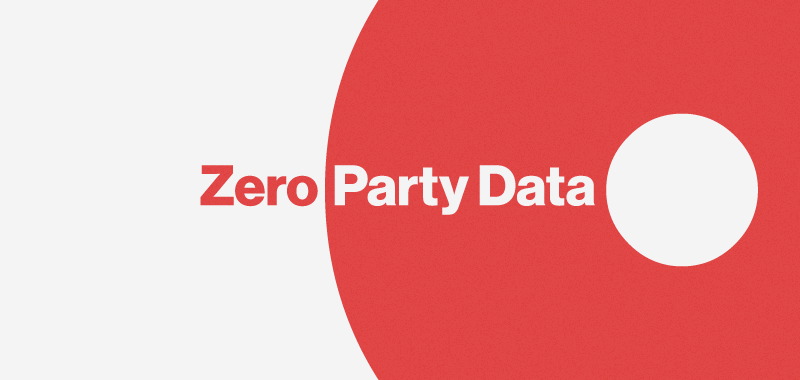
In the new era of data, zero-party is digital gold.
Data is becoming increasingly integral as brands seek to understand more about their customers. But as this desire for customer data grows, so privacy concerns become increasingly challenging.
Growing consumer and government scrutiny is causing a major shift away from a reliance on traditional third-party data to a new model.
Consumers will increasingly be given the power to know: 1) what companies know about them and 2) decide what and how much data they choose to share.
This type of data is referred to as ‘zero-party data’.
What is zero party data?
Zero party data can be defined as data that is owned by the consumer that they intentionally and proactively share with a brand that they trust. The consumer retains ownership of the data but gives consent to a brand to use their zero-party data.
Consumers will typically share this type of data in exchange for some form of value or benefit from a brand.
An example of this value exchange would be a member of a loyalty program completing a quiz or filling in preference centre data in exchange for a reward like a voucher or bonus points. Value can also be delivered intangibly, such as providing the loyalty program member with a superior customer experience with personalised product suggestions.
Although historically similar to first-party data, the key difference with zero-party data is the consumer willingly shares their own interests, preferences and intentions – the data is explicit rather than implicit.
First party data is data which is collected via customer interaction which the company owns. It includes website and point-of-sale interactions, or any other information directly tied to the customer but not intentionally shared. A customer’s interests and purchase intentions can be inferred from previous behaviour and compared with the broader customer base, but it remains implicit. First-party does not tell the full picture.
Second party data is another company’s first party data that has been acquired through a commercial agreement.
Third party data is any information collected from outside sources that are not directly the company’s own, such as cookies or data sets from major data exchanges (aggregators).
The Death of the Third-Party Cookie
New laws and industry changes around how consumer data is collected, managed and used are rapidly evolving. Industry regulations such as GDPR and the CCPA have put increasing pressures on companies to put the privacy of consumer data first and foremost.
Brands have relied on third-party cookies for decades as the primary tool to build out customer profiles for marketing and retargeting purposes. This is fundamentally changing.
For many digital marketers, the nail in the coffin came when Google announced it would phase out Chrome’s support of third-party cookies by 2022; a browser that accounts for 65% of all web traffic. Other major players such as Apple and Firefox have led the trend for some years.
One only needs to look at all the fuss surrounding the new iOS 14 privacy update to see where we are heading; a privacy-first approach is the future.
Needless to say, this does not mean a complete eradication of all third-party data – good data will always remain good data – but it will cause a seismic shift in demand by digital marketers for zero- and first- party data.
Brands will place a greater reliance on data their customers knowingly share with them. In fact, they will have to.
How To Collect Zero-Party Data
Brands must remember collecting zero-party data is not a zero-sum game.
Explicit information about customer intentions, straight from the source, provides the perfect basis to understand and deliver to a customer’s needs, but it does not come free. Brands must provide some form of value in exchange for a customer sharing their personal information.
Loyalty programs are one of the most effective means to collect zero-party data because they make it inherently clear to the member what the value exchange is. They are formalised systems of exchanging value (i.e., rewards for information, and vice versa).
When a customer signs up for a loyalty program, they sign up because they perceive there is value. They are happy to share their personal information because they value what the brand offers them for signing up. It is up to the brand to continue to offer incremental value to encourage a customer to share further.
There are a variety of techniques and tools a brand can use within a loyalty program to collect and encourage the sharing of zero-party data, including:
- preference centres,
- surveys, polls and quizzes,
- giveaways and competitions,
- games and gamification,
- social posts and stories,
- and forums and communities.
The added bonus of a loyalty program is the unique position it provides a brand to collect and unify data across channels. Marketers can take full advantage of this single customer view by supporting it with personalised lifecycle communications and experiences.
With great data comes great responsibility
Remember, zero-party data is information owned and intentionally shared by a consumer. It’s how the individual wants the brand to recognise them.
Consumer data should be respected, not exploited.
Just because someone opted-in once to share their interests or complete a quiz, it doesn’t mean they will always be interested in sharing personal information.
Similarly, expressing interest in one email doesn’t mean the customer has granted a brand permission to fill their inbox every time the brand has something to say (or sell). Years ago, Seth Godin popularised this idea of ‘permission marketing’, and it is as pertinent and relevant to zero-party data as to email.
As we increasingly move towards a privacy-first future, the data-conscious consumer will determine their own willingness to participate.
Brands which respect and use zero-party data to better the customer experience will benefit twofold. They will learn more and convert more.
These are the brands who will increase in value and effectiveness.

